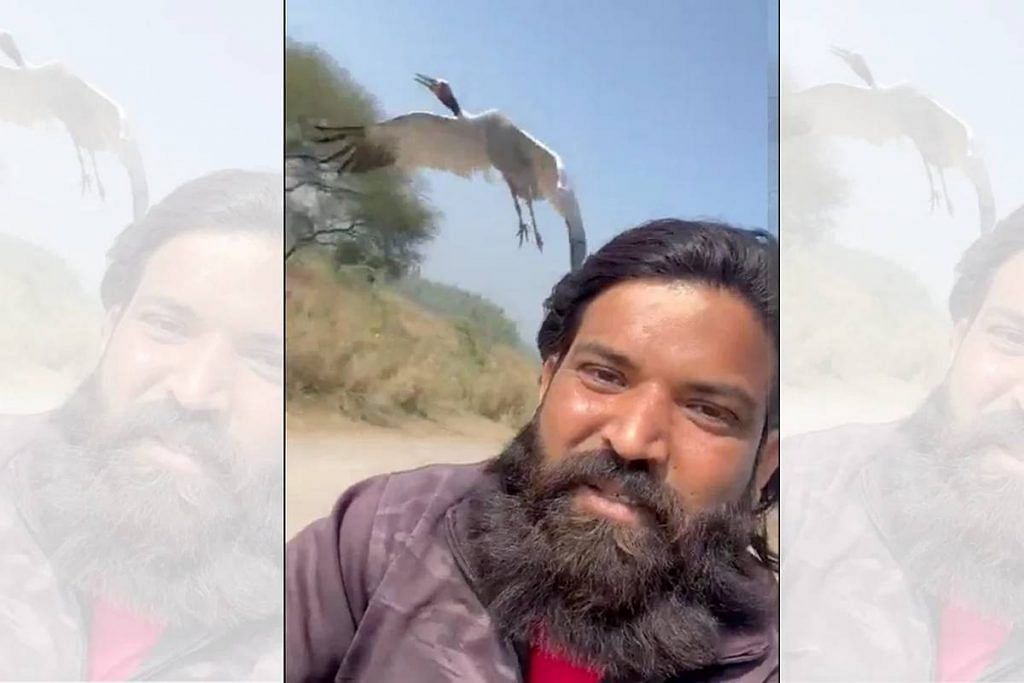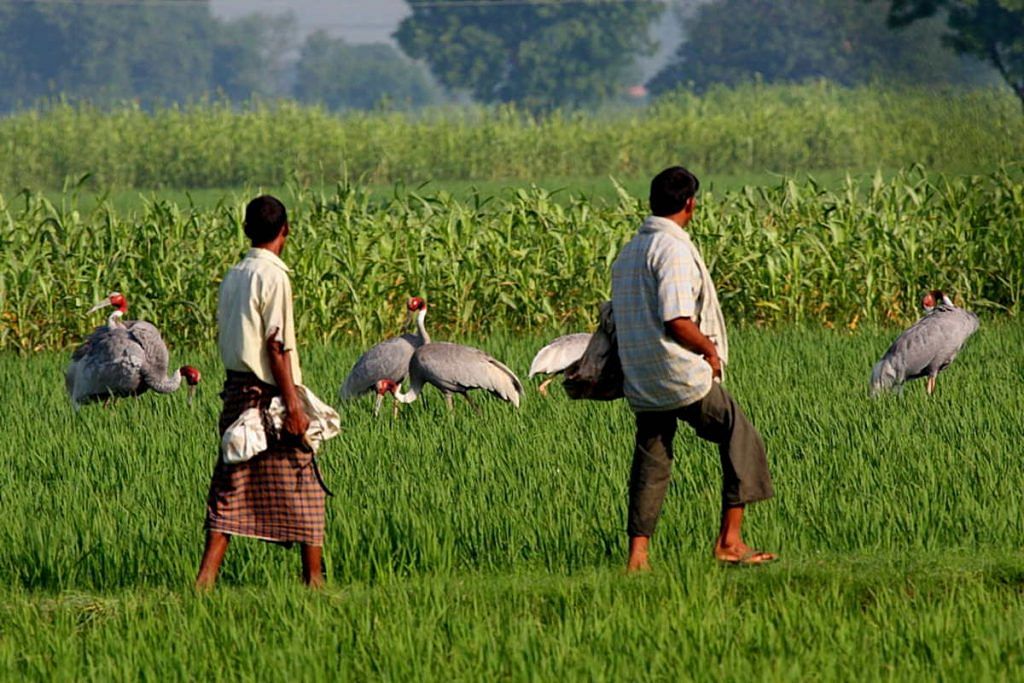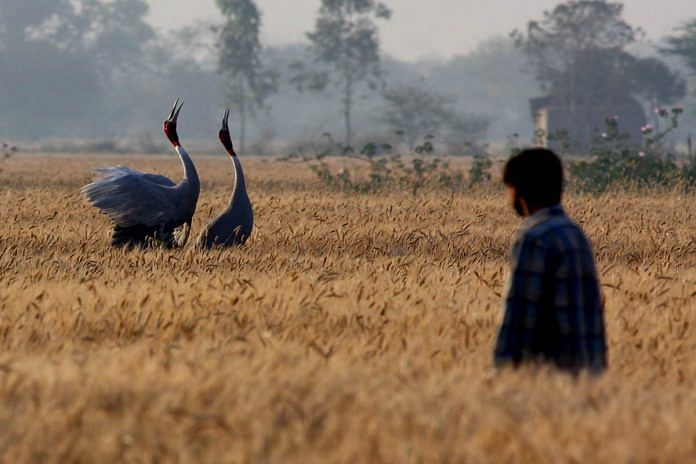Bengaluru: The story of Uttar Pradesh farmer Mohammed Arif’s “special bond” with a sarus crane has been an emotional rollercoaster. When authorities seized the bird from the man and booked him under the Wildlife Protection Act, some saw it as a cruel parting, while others argued that the “friendship” should never have existed.
However, sarus crane experts that ThePrint spoke to painted a more nuanced picture.
“While the story is emotional, it is unfortunately not very black and white,” said K.S. Gopi Sundar, co-chair of the Stork, Ibis, and Spoonbill Specialist Group of the International Union for Conservation of Nature (IUCN). “This is an odd case, and there are many perspectives to consider, I think.”
The saga burst into public view in February when videos went viral of Arif riding a bike and the sarus crane flying close behind him in Amethi, Uttar Pradesh. Arif had reportedly taken care of the bird after it suffered an injury, reportedly earning its “loyalty”.
But even as the public’s heartstrings were tugged, forest officials took away the bird last Tuesday, citing the fact that sarus cranes are a protected species. The sarus crane was subsequently taken to Raebareli’s Samaspur Bird Sanctuary and then relocated to Kanpur Zoo this week, after it seemingly failed to be reintegrated into the wild.
Arif, meanwhile, was booked under the Wildlife Protection Act for illegally keeping the sarus crane. The bird is classified as “vulnerable” on the IUCN Red List of Threatened Species. It is also protected under Schedule 1 of the Wildlife (Protection) Amendment Act 2022, which comes into effect this April.
But between the bird’s popularity soaring and its subsequent confiscation by officials, many things went wrong, experts said.
Understanding the sarus’s behaviour, its social bonding processes, past rehabilitation experiments, and equation with farming communities, could provide authorities a better way to resolve the situation, they noted.
“This is a very unique situation… we have not seen an incident like this before,” said naturalist Kandarp Kathju, a leading expert on sarus cranes.
Both Kathju and Sundar agree that handling the situation successfully from this point on could set a useful precedent in cases involving human-bird relationships.
Also Read: Birds of a feather: An Amethi man rescued a sarus crane a year back; the two are now wingmen
What does the law say?
When 35-year-old Mohammad Arif saw the sarus crane (Antigone antigone) first standing to its full height, he would have no doubt noticed that it was nearly as tall as he was — as evident in pictures of the two.
Sarus cranes, specifically males, are the tallest flying birds in the world, and can reach a height of up to 1.8 metres or nearly six feet.
With their distinct grey colouring and vivid red necks, these birds are found in large swathes of the Indian subcontinent, including the Gangetic plains, Assam, West Bengal, and Kashmir.
According to the World Wildlife Fund (WWF), there are 15,000-20,000 sarus cranes in India. There are also populations of the bird in Pakistan’s Punjab, parts of southern Nepal, and in pockets of Australia and Southeast Asia. Sarus cranes are non-migratory and known to be highly territorial.
In India, sarus cranes are protected under the Wildlife Protection Act, which came into force in 1972 to protect animals endemic or native to the country.

The law prohibits capturing or hunting any of the species listed under Schedules I to IV, except for approved scientific research or in case of threat to human life. It also prohibits unauthorised possession or transportation of these animals and birds.
After last year’s amendment to the law, due to come in force on 1 April, sarus cranes are protected under Schedule I, which applies to endangered species. Penalties for violation of the law extend to up to seven years in prison and a fine of up to Rs 1 lakh.
Section 57 of the amended law says that if “it is established that a person is in possession, custody or control of any wild animal, captive animal”, they can be booked under the Act.
Arif’s story has evoked outrage, but there is also a view in the conservation community that once his story went viral, the authorities had no option but to act since not doing so could have raised questions at the international level.
It has further been argued that Arif’s example is not a model of successful rehabilitation and that the media had been irresponsible in portraying it as such.
According to this perspective, the purpose of wildlife rehabilitation is to ensure that animals stay free in their natural habitats and at a distance from humans.
But the ground realities in India are more complex, with the birds having adapted to life in villages over the centuries, experts say.
From Jahangir’s court to UP villages
Historical accounts and artwork suggest that sarus cranes and their relatives were popular attractions in royal courts, including that of Mughal emperor Jahangir, who is believed to have kept a mating pair in his imperial fountains.
Gopi said that Jahangir subjected his sarus cranes to scholarly scrutiny and his observations from the early 1600s have stood the test of time.
“When I started my work, we knew about the incubation period of these birds from five recorded studies and observations, and two of them came from Jahangir,” exclaimed Gopi with a laugh. “He banded a pair of the birds with golden bands, one on one bird’s left leg and the other’s right leg, and documented their behaviour in great detail.”
The birds are commonly depicted in historic and royal art, and are anthropomorphised in Asian mythology for their long-lasting bonds with mates.
Sundar said the birds have several other distinctive behavioural traits as well, including extreme territoriality and females taking on the onus of wooing a mate.
“It’s the females who fight for the males’ attention. Can you believe it?” Sundar laughed. “This is called sex-role reversal. Males are the ones that defend territories, and these birds are very fiercely territorial… Even if a crane flies over the territory of another one, these birds lose it,” he added.
However, over centuries, the birds have adapted to co-existing with humans in rural India.

Sundar, who has studied the birds for about two decades, said that some sarus cranes in India have taken to nesting in farmlands, especially paddy fields since these are similar to their natural habitat of marshy wetlands.
“Sarus cranes have been a part of Indian farming culture for some time now, and the role farmers have played in their conservation should not be underestimated,” he said.
In the wake of the Green Revolution, which saw rice paddies proliferating, sarus numbers in these areas grew, Sundar added.
“In some farming villages in UP and other states, children even have games associated with sarus cranes,” Kathju said. “They go near a pair of cranes that are feeding, and ask them what kind of wife a boy would have. If the male raises its head first, they say that the wife would be dominating.”
Many sarus cranes, too, have adapted to the patterns and rhythms of rural life. The birds typically nest a couple of weeks after the first rains of the monsoon, but in fields around Haryana and UP, they take their cues from farmers.
“These cranes don’t wait for rains,” Sundar explained. “They start nesting two days after the first farmer has flooded his field.”
Nevertheless, the bird-human balance is a tenuous one.
Sarus cranes have been able to find new habitat and nesting sites in farmlands, but urbanisation has also shrunk their natural habitats and territories.
An indicator of this, Sundar said, was birds living not only in pairs but sometimes in “triets”. This refers to groups of three, where an unrelated ‘nanny’ bird helps raise the chicks of the breeding pair.
“This acceptance of a third bird into a territory is a brand new behaviour change and shows that territories are shrinking due to concretisation,” he said.
Of human bonding
While one-on-one interactions between sarus cranes and humans are rare, they are not unheard of, said both Sundar and Kathju.
In fact, encouraging bonds with human caregivers used to be a popular conservation strategy, but it has fallen out of favour since some birds are not able to adapt to life in the wild after imprinting on humans as newborn chicks, they said.
Like many other precocial birds, or those that are born fully developed and ready to fly or move, sarus chicks bond with their first caretaker, typically their mother. This is often referred to as imprinting or the process of learning to identify an animal’s sense of species and self-identification, as well as learning appropriate behaviours.
When chicks were reared in captivity, they were encouraged to bond with one human, and then this person helped them readjust to the wild and get reintegrated, albeit not always successfully, Sundar said.
“The keeper would take the bird to an area occupied by a non-mating flock that hadn’t yet discovered their territories,” he said. “The person would then disappear for a while and then reappear, slowly getting the crane to be comfortable among other cranes in the absence of the human.”
Typically, he added, the crane would be able to reintegrate into the wild community over a few days — but there have been consistent exceptions with birds that imprinted on humans.
This is why this practice of human-bird bonding started to be avoided in conservation, Sundar explained. But a solution, he added, was found in humans dressing up in appropriate bird costumes, a practice that has aided bird conservation globally.
What next for Arif’s crane?
What to do with Arif’s crane next is unclear, said experts.
“This is a very odd case,” said Kathju. “What to do next will depend on the age of the crane and whether it is breeding.”
If it’s a non-breeding crane — which Kathju thinks it likely is, as it has reportedly flown away in the past but returned to Arif — it would ideally be released into a wild space occupied by flocks of other non-breeding, young cranes.
However, the situation becomes slightly more complicated when the crane is of breeding age.
“Then the alternative is to try and find a good home for it in a healthy zoo with a viable mate, because we know there are many cranes that need pairing,” Kathju said. “The authorities would have to determine its gender through testing and fix the bird with a potential mate.”
How this should ideally be done is a method that might be familiar to cat owners: separating the cranes into distinct enclosures where they can maintain visual contact for a couple of months. After that period, they could be gradually introduced to the same area under careful observation. Pairing them would be possible when they stop displaying hostility and begin to coexist peacefully, Kathju explained.
This, he added, takes time and patience, and very much depends on individual bird personalities.
And since the crane has already bonded strongly to Arif, the rehabilitation process should definitely include him, agreed both experts.
Currently, the crane is under quarantine in Kanpur Zoo. According to reports, the bird has started to exhibit depressive behaviour, which is not uncommon for animals that are kept in captivity, although zoo officials have told reporters that the crane is eating and behaving normally.
“In many ways it’s sort of like history repeating itself,” said Kathju. “We are newly documenting this change in behaviour among birds that we have known for centuries to be near us, and in that sense, it is very interesting and poetic.”
However, to ensure the success of the crane and its survival among humans, educating farmers on the behaviour of the cranes as well as wildlife laws is crucial, he added.
(Edited by Asavari Singh)
Also Read: Why was a sarus bonding with UP farmer? Media glorified friendship that shouldn’t have existed



